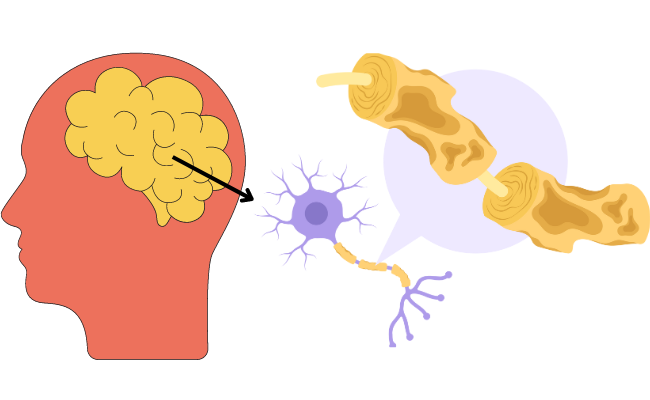How to Treat Neuromyelitis Optica?
- February 01, 2024
- No Comments

What is Neuromyelitis Optica (NMO)?
Neuromyelitis Optica (NMO), once known as Devic's disease, is a rare autoimmune disorder affecting the optic nerves and spinal cord. This condition, characterized by inflammation and damage to the myelin sheath surrounding nerve cells, has distinct clinical features. Formerly considered a rare subtype of multiple sclerosis (MS), NMO is now recognized as a separate autoimmune condition with its own unique characteristics and clinical manifestations.
The immune system's misguided attack on specific components of the central nervous system sets NMO apart from other neurological disorders. This distinction emphasizes the need for a specialized approach to diagnosis and management.
Why is Neuromyelitis Optica a Concern?
The concern surrounding Neuromyelitis Optica stems from its potential to cause severe and cumulative neurological damage. The autoimmune response directed at the central nervous system, specifically the optic nerves and spinal cord, can lead to recurrent attacks. These attacks result in inflammation, which, over time, causes cumulative disability. Vision loss, weakness, paralysis, and other neurological deficits are common consequences, impacting the overall quality of life for individuals affected by this disorder.
The potential for relapses and the unpredictable nature of the disease underscore the need for effective and comprehensive treatment strategies. Managing NMO requires a combination of immunosuppressive therapies, symptomatic relief, and ongoing monitoring to ensure timely adjustments to the treatment plan.
How to Identify Neuromyelitis Optica?
Identifying Neuromyelitis Optica involves recognizing its characteristic symptoms, which often manifest in distinctive ways. The key manifestations include:
- Optic Neuritis: This presents as sudden and severe vision loss or pain, typically affecting one eye initially. Optic neuritis is a hallmark feature that distinguishes NMO from other neurological conditions.
- Transverse Myelitis: Another characteristic manifestation is inflammation of the spinal cord, known as transverse myelitis. This can result in symptoms such as weakness, numbness, and, in severe cases, paralysis of the limbs or trunk.
- Pain: Individuals with NMO frequently experience severe pain, often radiating from the spine. This pain can be indicative of ongoing inflammatory processes within the central nervous system.
Diagnosing NMO involves a combination of clinical evaluation, neuroimaging studies, such as magnetic resonance imaging (MRI) scans, and specific laboratory tests. One crucial aspect of the diagnostic process is the detection of aquaporin-4 antibodies, which are associated with NMO and play a significant role in confirming the diagnosis.
Treatment Solutions for Neuromyelitis Optica
- Immunosuppressive Medications: The primary strategy for managing NMO involves the use of immunosuppressive medications. Corticosteroids, azathioprine, mycophenolate mofetil, rituximab, and other immunomodulatory drugs are commonly prescribed. These medications aim to suppress the autoimmune response, reducing the frequency and severity of relapses.
- Plasma Exchange (Plasmapheresis): In cases of severe attacks, especially those resistant to standard treatments, plasma exchange may be employed. Plasma exchange involves removing a patient's blood, separating plasma containing harmful antibodies, and replacing it with a substitute. This process helps control acute symptoms and can promote a more rapid recovery.
- Symptomatic Treatment: Managing specific symptoms is an essential aspect of NMO treatment. For instance, pain medications may be prescribed to alleviate discomfort, and rehabilitation services may be utilized to improve mobility and overall functionality.
- Ongoing Monitoring and Adjustments: Given the chronic and unpredictable nature of NMO, ongoing monitoring is essential. Treatment plans may need to be adjusted based on an individual's response and any emerging symptoms. Regular check-ups and imaging studies help healthcare providers assess disease activity and tailor treatment accordingly.
Benefit Points of Neuromyelitis Optica Treatment
- Relapse Prevention: Immunomodulatory medications play a crucial role in preventing relapses and reducing the frequency of attacks. By modulating the immune response, these medications aim to minimize neurological damage over time.
- Symptom Management: Treatment strategies focus on alleviating specific symptoms, improving the overall quality of life for individuals with NMO. This includes managing pain, optimizing visual function, and addressing mobility issues.
- Enhanced Recovery: Plasma exchange can be a beneficial intervention during acute attacks, facilitating a faster and more complete recovery by removing pathogenic antibodies from the blood.
- Improved Functionality: Symptomatic treatment and rehabilitation services contribute to improved functionality, allowing individuals with NMO to maintain independence and engage in daily activities.
- Quality of Life: The comprehensive approach to NMO management aims to enhance the overall quality of life for affected individuals by minimizing disability, optimizing function, and preventing relapses.
- Long-Term Stability: With appropriate and ongoing treatment, individuals with NMO can achieve long-term stability, reducing the impact of the disease on their daily lives.
Comments (0)